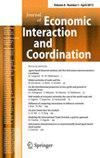参数化响应零情报交易员
IF 1
4区 经济学
Q3 ECONOMICS
Journal of Economic Interaction and Coordination
Pub Date : 2023-05-30
DOI:10.1007/s11403-023-00388-7
引用次数: 0
摘要
本文介绍了参数化响应零智能(PRZI),这是一种新的零智能(ZI)交易者,旨在用于连续双拍卖市场的动态模拟研究。与Gode和Sunder的经典ZIC交易员一样,PRZI从特定范围内离散值允许报价的随机分布中生成报价。与使用均匀分布来生成价格的ZIC不同,PRZI交易者的概率分布是以这样一种方式参数化的,即其概率质量函数(PMF)由一个在$$[-1.0, +1.0]$$[- 1.0, + 1.0]范围内的实值控制变量s决定,该控制变量决定了该交易者的策略。当$$s=0$$ s = 0时,PRZI交易者的行为与ZIC策略相同,具有统一的PMF;但当$$s \approx \pm 1$$ s≈±1时,PRZI交易者的PMF最大程度地向价格范围的一个极端或另一个极端倾斜,从而使其产生的价格或多或少“紧急”,使报价分布偏向或远离交易者的限价。为了探索动态调整其策略的PRZI交易者群体的共同进化动力学,我展示了长期市场实验的初步结果,其中每个交易者使用简单的随机爬坡算法反复评估备选s值,并在任何给定时间选择最有利可图的。在这些实验中,任何特定s值的盈利能力都可能是非平稳的,因为一个交易者在任何时候的策略盈利能力都可能取决于其他交易者在同一时间所采取的策略组合,而这些策略各自都在不断地适应。这些市场实验的结果表明,交易者的策略群体可以表现出丰富的动态,稳定期持续超过数十万个交易者的互动,偶尔会有变化。PRZI交易员和随机爬山者的Python源代码已经在GitHub上公开提供。本文章由计算机程序翻译,如有差异,请以英文原文为准。

Parameterised response zero intelligence traders
Abstract I introduce parameterised response zero intelligence (PRZI), a new form of zero intelligence (ZI) trader intended for use in simulation studies of the dynamics of continuous double auction markets. Like Gode and Sunder’s classic ZIC trader, PRZI generates quote prices from a random distribution over some specified domain of discretely valued allowable quote prices. Unlike ZIC, which uses a uniform distribution to generate prices, the probability distribution in a PRZI trader is parameterised in such a way that its probability mass function (PMF) is determined by a real-valued control variable s in the range $$[-1.0, +1.0]$$ [ - 1.0 , + 1.0 ] that determines the strategy for that trader. When $$s=0$$ s = 0 , a PRZI trader behaves identically to the ZIC strategy, with a uniform PMF; but when $$s \approx \pm 1$$ s ≈ ± 1 the PRZI trader’s PMF becomes maximally skewed to one extreme or the other of the price range, thereby making it more or less “urgent” in the prices that it generates, biasing the quote price distribution towards or away from the trader’s limit price. To explore the co-evolutionary dynamics of populations of PRZI traders that dynamically adapt their strategies, I show initial results from long-term market experiments in which each trader uses a simple stochastic hill-climber algorithm to repeatedly evaluate alternative s -values and choose the most profitable at any given time. In these experiments the profitability of any particular s -value may be non-stationary because the profitability of one trader’s strategy at any one time can depend on the mix of strategies being played by the other traders at that time, which are each themselves continuously adapting. Results from these market experiments demonstrate that the population of traders’ strategies can exhibit rich dynamics, with periods of stability lasting over hundreds of thousands of trader interactions interspersed by occasional periods of change. Python source code for PRZI traders, and for the stochastic hill-climber, have been made publicly available on GitHub.
求助全文
通过发布文献求助,成功后即可免费获取论文全文。
去求助
来源期刊
CiteScore
2.20
自引率
18.20%
发文量
33
期刊介绍:
Journal of Economic Interaction and Coordination addresses the vibrant and interdisciplinary field of agent-based approaches to economics and social sciences.
It focuses on simulating and synthesizing emergent phenomena and collective behavior in order to understand economic and social systems. Relevant topics include, but are not limited to, the following: markets as complex adaptive systems, multi-agents in economics, artificial markets with heterogeneous agents, financial markets with heterogeneous agents, theory and simulation of agent-based models, adaptive agents with artificial intelligence, interacting particle systems in economics, social and complex networks, econophysics, non-linear economic dynamics, evolutionary games, market mechanisms in distributed computing systems, experimental economics, collective decisions.
Contributions are mostly from economics, physics, computer science and related fields and are typically based on sound theoretical models and supported by experimental validation. Survey papers are also welcome.
Journal of Economic Interaction and Coordination is the official journal of the Association of Economic Science with Heterogeneous Interacting Agents.
Officially cited as: J Econ Interact Coord

 求助内容:
求助内容: 应助结果提醒方式:
应助结果提醒方式:


